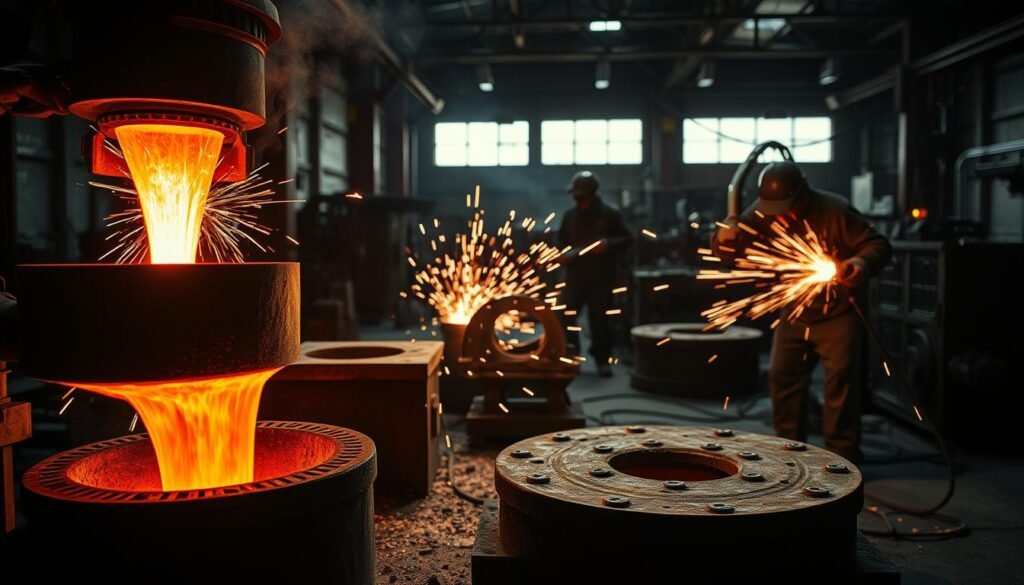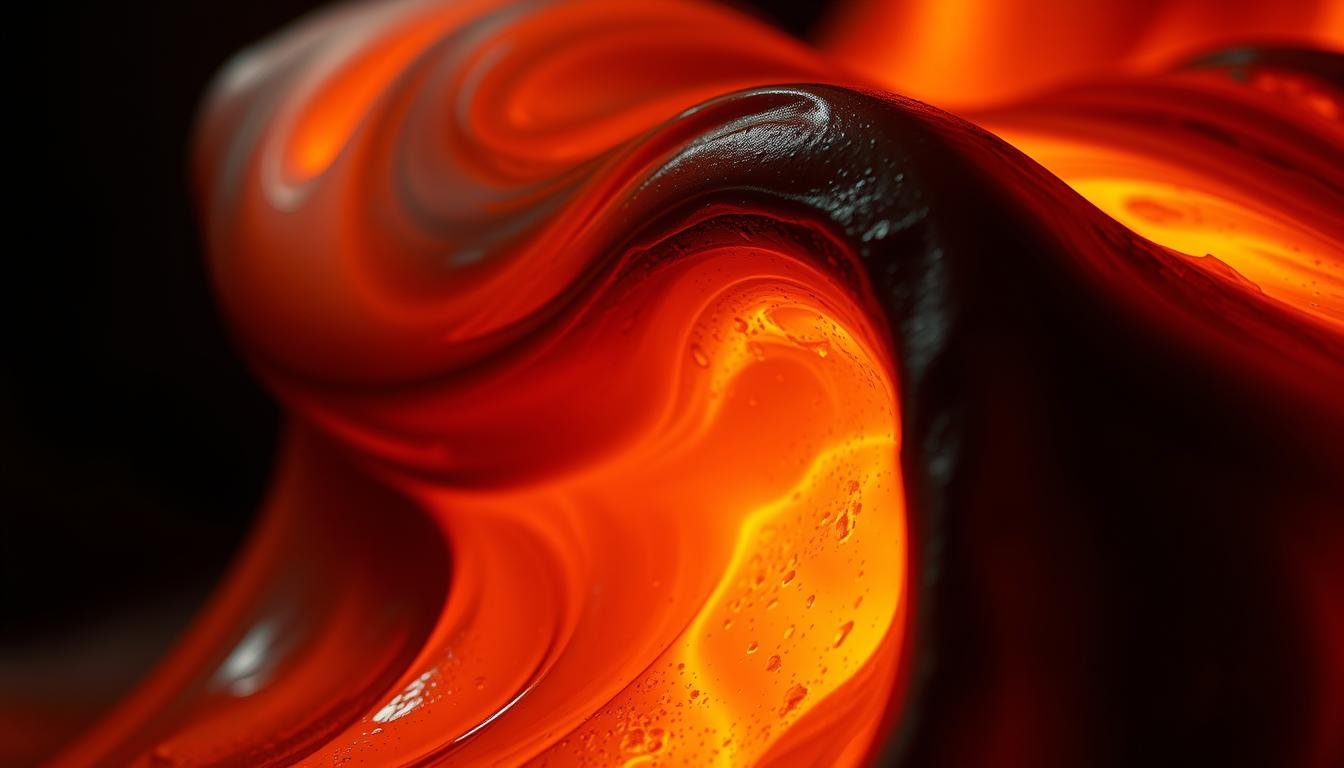Understanding thermal properties is essential for professionals working with industrial materials. This knowledge directly impacts manufacturing efficiency, product quality, and workplace safety. One critical factor in metal processing involves knowing precise heat thresholds for phase changes.
The alloy containing carbon and silicon melts at 1,150–1,200°C (2,102–2,192°F). This range is notably lower than pure elemental forms, enabling practical applications in casting and shaping. The reduced heat requirement allows cost-effective production while maintaining structural integrity.
Manufacturers rely on these thermal characteristics for automotive parts, machinery components, and construction elements. Proper furnace selection and energy management depend on accurate temperature data. Did you know? Composition variations like 2.1–4% carbon content significantly alter material behavior during heating cycles.
Modern industries prioritize precise thermal control to achieve desired mechanical properties. From welding protocols to mold creation, every step benefits from understanding this fundamental parameter. Professionals must balance heat application with safety standards to optimize outcomes in diverse industrial settings.
Understanding Cast Iron and Its Melting Behavior
The behavior of industrial alloys under heat plays a crucial role in manufacturing processes. Specific combinations of elements create unique thermal responses, particularly during phase transitions. This knowledge helps engineers optimize production methods and ensure material reliability.
Defining Its Composition
This alloy contains over 2% carbon and 1–3% silicon, distinguishing it from similar materials. Carbon exists in distinct forms depending on production methods. For example, graphite flakes form in grey variants, while white types contain iron carbide. Silicon acts as a catalyst, encouraging carbon to separate into stable structures.
How Heat Affects Structural Changes
When heated, these alloys transition through a semi-liquid state rather than melting abruptly. This “mushy zone” occurs because different components respond to temperature changes at varying rates. Carbon-rich areas liquefy first, followed by iron-dominated regions. This staggered process demands precise furnace adjustments to maintain quality.
Variations in microstructure also influence thermal responses. Grey types with layered graphite melt more predictably than white versions with carbide clusters. The ideal carbon-to-iron ratio creates a balanced eutectic mixture, lowering energy requirements for casting applications.
What is the Cast Iron Melting Point?
Precise thermal parameters determine success in metal fabrication. Materials reach critical phases where structural changes occur, directly impacting production outcomes. This threshold varies significantly between alloys, requiring careful monitoring during industrial processes.
Temperature Ranges and Standards
Industrial guidelines specify a primary heat range of 1,150–1,200°C (2,102–2,192°F) for transitioning to liquid form. This represents a 300°C reduction compared to elemental forms, enabling energy-efficient operations. Most commercial grades stabilize near 1,175°C (2,147°F), serving as a benchmark for furnace calibration.
Variations in carbon and silicon levels shift these thresholds. Alloys near the eutectic mixture achieve optimal flow characteristics at lower energy costs. Even 50-degree deviations alter material viscosity, affecting mold filling and product durability.
Modern foundries implement strict protocols using advanced pyrometers and automated controls. These systems maintain thermal stability within ±10°C, ensuring consistent results across production batches. Such precision prevents structural flaws while reducing fuel consumption by up to 18% in large-scale operations.
Importance of Melting Points in Metalworking
Accurate temperature knowledge separates quality products from failures in industrial manufacturing. When materials approach their critical thermal limits, components risk deformation or complete structural collapse. This understanding drives success in essential processes like welding, casting, and alloy development.
Fabricators rely on precise heat data to choose equipment capable of handling specific thermal demands. Furnaces and welding torches must operate within safe thresholds to prevent dangerous malfunctions. Proper calibration ensures tools withstand extreme conditions while protecting workers.
Material selection becomes vital for high-heat environments. Components like engine parts or industrial reactors require metals that maintain strength far below their phase transition points. “You can’t design a turbine blade without knowing its thermal breaking point,” notes a aerospace engineer.
In joining techniques, mismatched melting temperatures cause weak bonds or material degradation. Professionals synchronize base and filler metals’ heat responses to create durable seams. Modern facilities use automated systems to maintain ±15°C precision during these operations.
The economic benefits of thermal mastery extend across industries. Reduced energy waste, fewer defective products, and faster production cycles all stem from optimized temperature management. This efficiency directly impacts profitability in competitive markets like automotive and construction.
Factors Influencing the Melting Point of Cast Iron
Multiple variables dictate how industrial alloys respond to heat treatment during production. Foundries must evaluate both intrinsic material properties and external conditions to achieve precise phase transitions. Let’s examine the critical factors shaping these thermal thresholds.
Alloy Composition and Impurities
Carbon content serves as the primary driver of thermal behavior. Higher concentrations reduce energy requirements for phase changes by altering atomic arrangements. Silicon amplifies this effect, promoting graphite formation that weakens structural bonds. Conversely, elements like chromium strengthen molecular connections, demanding more heat for liquefaction.
Even minor impurities disrupt lattice stability. Trace sulfur or phosphorus creates microscopic defects that lower resistance to thermal stress. “A 0.1% impurity shift can change furnace settings by 50°C,” explains a metallurgical engineer. This variability necessitates rigorous material testing before processing.
External Pressure and Bonding Types
Atmospheric conditions play a surprising role in thermal transitions. Increased pressure counteracts volume expansion during melting, forcing operators to apply additional energy. Facilities operating at high altitudes often require modified furnace parameters compared to sea-level counterparts.
Bonding structures within the material further complicate predictions. Metallic bonds in ferritic matrices withstand higher temperatures than pearlitic regions with mixed bonding types. Understanding these interactions helps optimize thermal behavior in casting processes while maintaining cost efficiency.
Comparing Cast Iron to Other Metals
Material selection in manufacturing hinges on understanding thermal characteristics across alloys. Different melting points directly influence energy costs, tool requirements, and application suitability. This comparison helps professionals balance performance needs with operational efficiency.
Melting Temperatures Across Metals
Structural metals vary widely in heat resistance. While cast iron transitions to liquid at 2,060–2,200°F, stainless steel requires temperatures near 2,750°F. This 500–600°F difference creates significant energy savings when processing cast iron vs steel components.
Titanium stands out with a 3,040°F threshold – nearly 1,000°F higher than cast iron. This makes titanium ideal for aerospace applications but less practical for high-volume casting. Aluminum’s low 1,220°F melting point suits lightweight products, though it lacks cast iron’s durability.
Recycling operations leverage these variations through selective heating. Factories can separate metals like copper (1,983°F) from cast iron using precise temperature controls. Such processes reduce waste while recovering valuable materials.
Understanding these thermal profiles allows engineers to optimize production costs. Lower heat requirements translate to faster cycles and reduced fuel consumption. As one foundry manager notes: “Choosing the right metal cuts our energy bills by 20% annually.”
The Role of Melting Temperature in Casting and Welding
Precision heat management forms the backbone of successful metal fabrication. In operations requiring liquefaction, thermal thresholds dictate equipment choices and procedural accuracy. Proper temperature control ensures materials flow correctly while maintaining structural reliability.

Considerations in Fabrication Processes
Complete material liquefaction remains critical for mold filling and component precision. Furnace selection directly correlates with thermal requirements—operators often choose induction systems for rapid, controlled heating. Thermal expansion during phase changes demands calculated mold designs to prevent warping or stress fractures.
Foundries use specialized ladles lined with refractory materials capable of handling extreme heat. Pouring techniques must account for cooling rates to achieve uniform solidification. For detailed comparisons, consult guides on melting points of industrial metals.
Impact on Welding and Machine Part Integrity
Excessive heat during joining operations risks altering microstructures near weld zones. Professionals implement preheating protocols to minimize thermal shock and cracking. Controlled cooling rates preserve ductility in finished joints.
Machine components exposed to cyclic heating require materials with stable properties across temperature ranges. “A 50°C overshoot can turn a reliable gear into scrap metal,” notes a quality assurance specialist. Advanced welding torches now feature real-time thermal feedback to maintain optimal conditions.
Historical and Modern Production of Cast Iron
Metalworking history reveals transformative innovations that shaped civilizations. Early breakthroughs in material processing laid foundations for today’s industrial practices. The journey from rudimentary methods to precision engineering highlights human ingenuity in harnessing natural resources.
Evolution from Ancient Techniques to Today’s Methods
Chinese artisans pioneered iron processing in the 8th century BC, creating tools and ceremonial objects. Their charcoal furnaces achieved temperatures sufficient to liquefy ore—a revolutionary step in metallurgy. By the 15th century, European armies adopted these methods to forge cannons, expanding military capabilities.
Modern production uses electric induction systems for precise heat management. These systems maintain optimal thermal conditions while reducing energy waste by 40% compared to traditional methods. Advanced sensors now monitor every phase of the melting process, ensuring consistent quality.
From ancient clay molds to automated foundries, temperature control remains central to success. Contemporary engineers balance historical wisdom with cutting-edge technology, driving sustainable advancements in metal fabrication. This fusion of old and new continues to redefine industrial possibilities.
